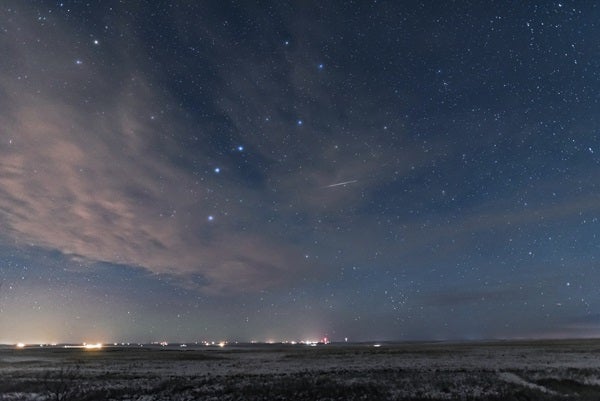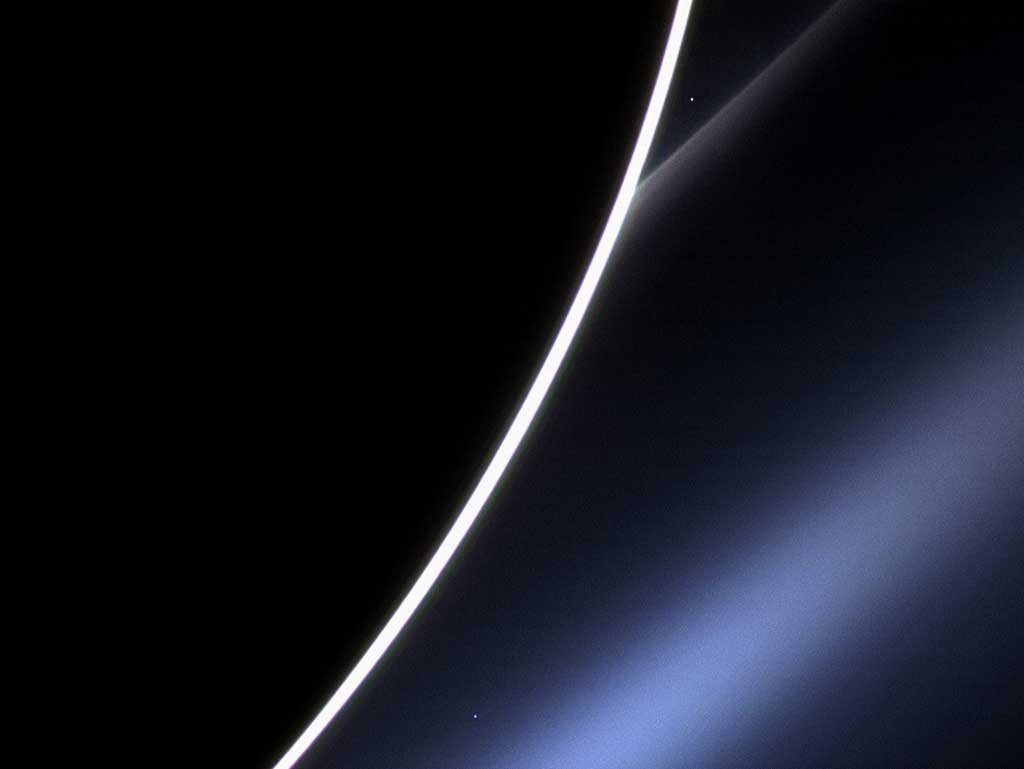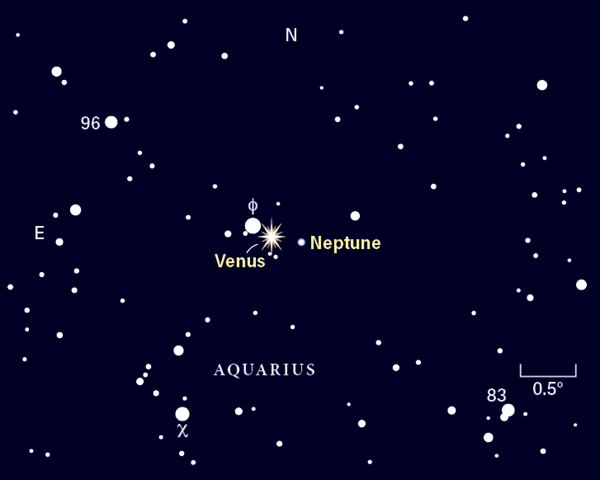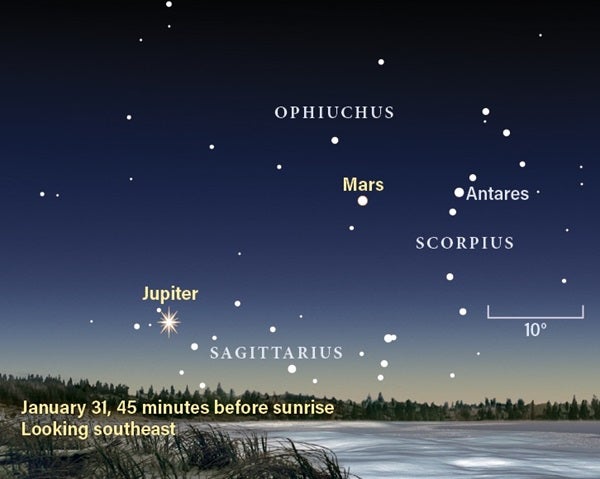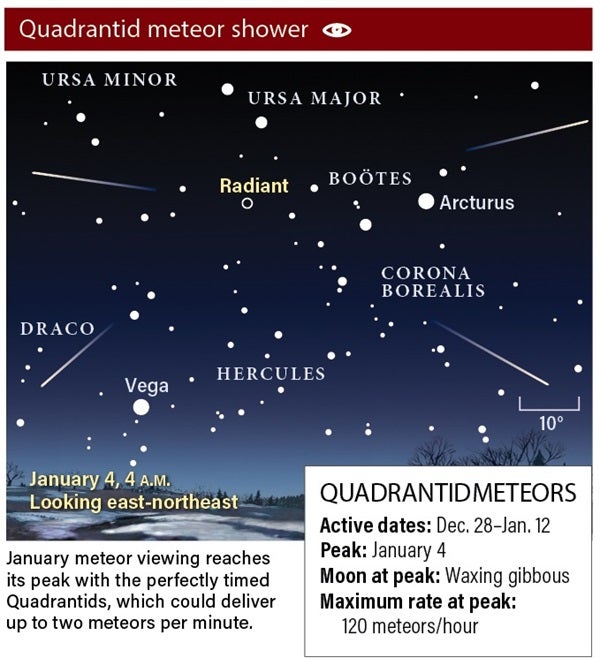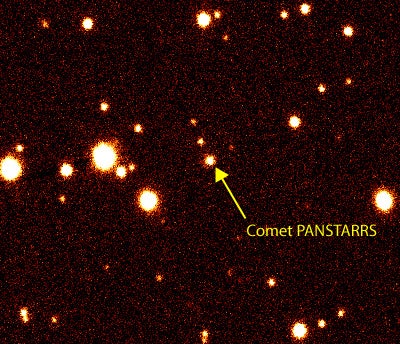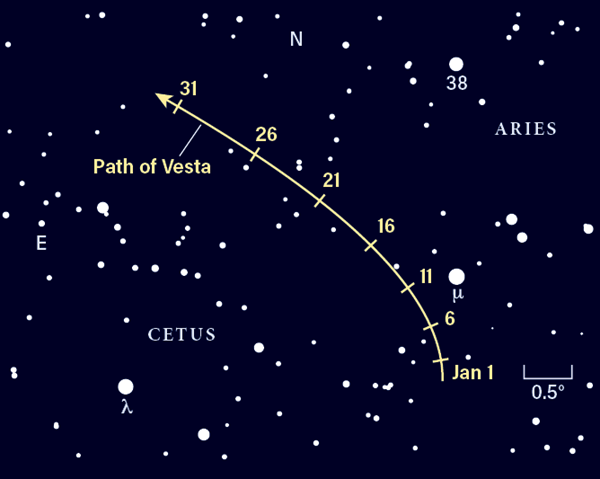Let’s begin our tour as the sky starts to darken. The first evening of the New Year finds Venus shining brilliantly above the southwestern horizon. The magnitude –4.0 planet stands 16° high an hour after sunset. A six-day-old waxing crescent Moon appears high above it in the south, while the seasonally challenged stars of the Summer Triangle dip low in the west and northwest.
Here’s how to find the normally elusive Neptune: As darkness falls on the 26th, target Venus with binoculars or a telescope at low power. Note the 4th-magnitude star Phi (ϕ) Aquarii 1.4° above it. Neptune lies two-thirds of the way from Venus to Phi. The outer planet appears as a faint dot, glowing at magnitude 7.9. Don’t confuse it with the slightly brighter star that stands 0.5° to its right.
Neptune proves easier to find the following night, when it passes just 5′ north of Venus — the closest approach between these two planets since January 1984. The conjunction occurs at 2 p.m. EST, which places western Europe in the best viewing spot. By the time night falls across North America a few hours later, Neptune lies 12′ west of Venus while Phi stands a nearly equal distance to Venus’ east-northeast. Although 10×50 binoculars will separate the three objects, Neptune may be a challenge to see in Venus’ glare. A telescope shows the trio much more clearly.
As if to draw attention to this extraordinary conjunction, a slender crescent Moon appears 7° below the two planets. Imagers should take advantage of the opportunity to capture the scene with some attractive foreground objects.
Although the two worlds appear near each other in our sky, a large expanse of space separates them. Venus resides in the inner solar system, closer to the Sun than Earth, and lies 104 million miles from us at the time of the conjunction. Neptune is the solar system’s most distant major planet and stands 2.85 billion miles away. These distances dramatically affect what you see through a telescope. Despite having a physical diameter four times larger than Venus, Neptune appears only 2.2″ across while Venus spans 15″.
While you’re waiting for the sky to darken and Neptune to emerge, lower your gaze toward the horizon. That’s where you’ll find Mercury during the last week of January. Your first opportunity to see it comes on the 25th. If you have a clear sky and an unobstructed horizon toward the west-southwest, search for a wafer-thin crescent Moon hanging 3° high 30 minutes after the Sun sets. Once you find it, hunt for magnitude –1.1 Mercury 2° to its right. You’ll have only about 10 minutes to catch them before they sink out of sight.
Your chances of spotting Mercury improve as the month winds down because it gains nearly 1° of altitude with each passing day if you observe at the same time relative to sunset. On the 31st, the planet stands 6° high a half-hour after sundown. Its altitude will nearly double by the time it reaches greatest elongation during February’s second week.
Uranus lies high in the southern sky during the early evening hours and makes a fine target through binoculars or a telescope. It lies among the background stars of Aries, 12° due south of the Ram’s brightest star, 2nd-magnitude Hamal (Alpha [α] Arietis). The magnitude 5.8 planet glows brightly enough to see easily through binoculars if you know where to look. But that’s the challenge — few guide stars lie nearby to help your search.
Start by finding Hamal and magnitude 3.8 Alpha Piscium, which resides in southeastern Pisces. This unassuming star lies 21° south of Hamal and appears 20 percent as bright. Use binoculars to scan between these stars and get used to how many fields of view separate them. Then estimate their midpoint and drop 1° south of this spot to find Uranus.
A few other stars lurk in Uranus’ vicinity. Four of these 6th- and 7th-magnitude suns form a slightly crooked line that extends 4° north-south. The planet, which glows a little brighter than these field stars, lies just west of the line during January’s first three weeks. Uranus’ eastward motion against this backdrop makes it a fifth member of the line by month’s close.
Once Uranus sets — near 2 a.m. local time in early January and midnight late in the month — the sky remains empty of planets until Mars shows its ruddy face around 4 a.m. Within an hour or so, you can find it low in the southeast along with its ancient rival, Antares. The Red Planet brightens from magnitude 1.6 to 1.4 during January and appears slightly fainter than the magnitude 1.1 red supergiant star. Mars passes 5° north of Antares in mid-January.
As dawn starts to break about 90 minutes before sunrise, the Red Planet stands 15° above the horizon. Embedded among the background stars near the Scorpius-Ophiuchus border, Mars is a sight to behold in the predawn darkness, particularly January 20, when a waning crescent Moon appears above the planet and Antares. Unfortunately, a telescope reveals a featureless Mars with a disk less than 5″ in diameter.
Jupiter reappears in the morning sky during January’s second half. An hour before sunrise on the 22nd, a slim crescent Moon appears 7° to Jupiter’s upper right. The pair looks gorgeous against the twilight glow. The planet shines at magnitude –1.9 and shows up easily in the brightening sky. Jupiter’s visibility improves through the end of the month, when it climbs 7° high in the southeast 45 minutes before the Sun rises.
Saturn is in conjunction with the Sun on January 13, coincidentally the same day that the two brightest dwarf planets, Pluto and Ceres, reach the same milestone. The ringed planet reemerges before dawn by the 31st, but just barely. You might be able to catch its magnitude 0.6 glow through binoculars just 3° high in the southeast 30 minutes before sunup. Much better views await observers this spring and summer.
The Moon dips into Earth’s shadow January 10, bringing a penumbral lunar eclipse to residents across Europe, Africa, Asia, and Australia. During a penumbral eclipse, the Moon passes through our planet’s lighter outer shadow but does not enter the darker umbral shadow. (If you were an astronaut visiting the Moon, you would see Earth partially eclipsing the Sun.) The event lasts from 17h06m to 21h14m UT and peaks at 19h10m UT. At maximum, 92 percent of Luna lies in Earth’s penumbra, and the Moon’s southern half will darken noticeably.
Rising moon: Fabulous Fracastorius finds the spotlight
There’s more to lunar history than younger craters erasing older features. For example, the massive impact that carved out Mare Nectaris (Sea of Nectar) affected the face of cratering for millions of years. The Sun nicely illuminates Mare Nectaris on January 1. Three intriguing craters on the sea’s western side immediately catch the eye, as does the bright white arc of Rupes Altai. Perfectly centered on Nectaris, the arc is a remaining section of the fourth rim of this multiring basin.
The younger crater Piccolomini dangles on the southern end of Rupes Altai like a hoop earring. Spanning 55 miles, Piccolomini is big enough that it sports a complex of central peaks instead of a single one like those seen in the many smaller pockmarks that pepper the surroundings. Also check out its walls. Similar to a hole dug in wet sand at the beach, lots of material slumped into Piccolomini’s cavity. The crater’s southern side has more thanks to the unstable terrain generated when Rupes Altai formed.
The broken circle of the 75-mile-wide crater Fracastorius is intermediate in age between Nectaris and Piccolomini. Just as water finds its level, so does lava, which makes it clear that Fracastorius tilts down to the north. Lunar geologists have deduced that before the final flood in this region, a smaller surge of lava rose up through cracks in Nectaris’ floor, solidified, and depressed the central part. This caused the surrounding terrain to tilt down toward the sea’s center. By the way, Fracastorius did not get its name because it is fractured; instead, it honors the 16th-century Italian astronomer, physician, and poet Girolamo Fracastoro.
If you miss viewing the Moon on New Years’ Day, similar lighting returns January 30. Watch the peaks of Rupes Altai and Piccolomini pop into view one by one as the evening progresses. With the Sun rising slowly over this rugged lunar terrain, high points to the west and lower points to the east light up with each passing half-hour.
Meteor watch: A short but dynamic shower
The year’s first meteor shower not only ranks among the best, but also among the least observed. Although the Quadrantids can produce up to 120 meteors per hour, January’s cold and often cloudy weather discourages viewers. The shower also has a sharp maximum, and meteor numbers remain above half the peak level for only four hours.
This year, however, conditions look great. The Quadrantids peak before dawn January 4 from North America, and the slightly gibbous Moon sets around 1 a.m. local time. If the sky cooperates, observers should be in for a great show. The meteors appear to radiate from northern Boötes — an area once occupied by the now-defunct constellation Quadrans Muralis — a region that climbs highest just before dawn.
Comet search: A performance fit for a queen
What seems to be shaping up as the Northern Hemisphere’s brightest comet of 2020 gets the year off to a nice start. Comet PanSTARRS (C/2017 T2) should reach 9th magnitude this month as it crosses the star fields along the border between Cassiopeia the Queen and Perseus the Hero.
An 8-inch telescope should pick up the comet’s compact glow from the suburbs. Crank the power to 150x or more and you’ll see an out-of-round shape and well-defined southern flank.
The observing window opens January 13, when the Moon rises about two hours after darkness falls. PanSTARRS then lies 1° north of the 4th-magnitude star Eta (η) Persei. Imagers shooting through a 70mm lens have two weeks to capture the comet’s glow crossing a wonderful Milky Way backdrop some 4° south of the Heart and Soul nebulae (IC 1805 and IC 1848, respectively).
Better yet, PanSTARRS passes less than 1° north of the Double Cluster on January 26 and 27. The comet moves slowly enough that the view should still be great a couple of nights before and after.
Locating asteroids: Vesta puts on a whale of a show
Although astronomers discovered three other asteroids before 4 Vesta, this denizen of the main belt typically shines brighter than any other. Vesta glows with the light of a magnitude 7.5 star this month, and you should have little trouble finding it through a small telescope from the suburbs or with binoculars from the country.
The asteroid rides high in January’s early evening sky, positioned against the backdrop of Cetus the Whale’s tail. This region lies far enough from the Milky Way that you should have little trouble picking it out of the background sky. In fact, with the exception of four or five stars, it will be the brightest object in your scope’s field of view. To find it, start at the 1st-magnitude orange giant Aldebaran in Taurus, then follow the point of the V-shaped Hyades star cluster westward (to the right) about three binocular fields. This will get you to the magnitude 2.5 star Alpha (α) Ceti. Shift north 5° or so from there to reach your anchor stars, Lambda (λ) and Mu (μ) Cet. The finder chart below then lets you zero in on Vesta’s position.
To see the asteroid change position in the course of a single observing session, look for it on the nights of January 13, 23, or 27. First note how it makes a crooked line or distinct triangle with a couple of background stars, then return in a couple of hours to find an altered pattern. On any other evening, sketch the four or five brightest objects in your scope’s field. When you return the next night, Vesta will be the “star” that moved.

